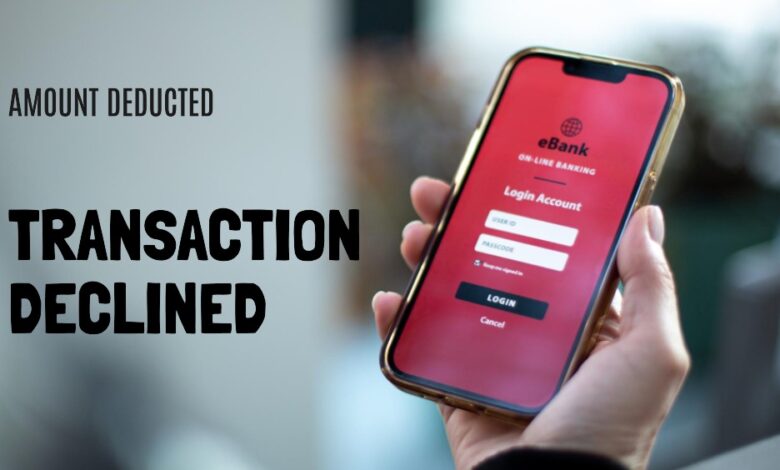Why my Transaction Declined but the Amount Deducted

Have you ever wondered, ‘Why was my transaction declined but the amount deducted?’ If so, you’re not alone. Many of us have faced this puzzling situation. In this article, we’ll unravel the mystery behind this common banking issue.
We’ll walk you through the inner workings of bank transactions, explore the reasons why a transaction might be declined, and yet, the amount gets deducted. More importantly, we’ll guide you on what to do when you find yourself in such a situation. So, let’s dive in and demystify this banking conundrum together.
Understanding Bank Transactions–
Banking, at its core, is a simple process. You deposit money, and the bank keeps it safe until you need it. But when it comes to transactions, things can get a bit more complex. A bank transaction involves transferring money from one account to another.
This could be between accounts at the same bank or different banks. The process might seem instantaneous, but it actually involves several steps. These steps are usually completed within a few seconds to a few minutes. However, sometimes, due to various reasons, a transaction might not go through as planned.
Understanding Unsuccessful Transactions: When Your Money Doesn’t Reach the Merchant/Seller
When you make a purchase using your credit card, and the deducted money fails to reach the merchant, it results in what is known as a failed transaction. This can occur both in online and offline transactions. It differs from a declined transaction, which is typically due to reasons like entering incorrect card details or exceeding the credit limit. In a failed transaction, the issue arises during the process involving the merchant, the payment gateway, and the issuing bank.
Transaction Status and Settlement
The status of a transaction may change immediately to “failed,” or it could initially be labeled as “pending” before transitioning to “failed” or “settled.” Settlement, the process of completing the transaction, may take up to 5 days. If the transaction isn’t settled within this timeframe, a reversal occurs, and the deducted amount is refunded to you. If the transaction is settled, but you didn’t receive the product or service, you can initiate a chargeback.
Appearance on Bills
Failed or pending transactions do not appear on your upcoming bill. In the case of a pending transaction with a significant amount, it’s advisable to wait before attempting the transaction again because your credit limit matching the transaction amount is temporarily blocked until settlement.
Checking Transaction Status
Pending transactions are visible in your transaction history, providing a clear overview of the ongoing status.
Reasons for Transaction Decline–
It can be quite frustrating when a transaction is declined, especially when you’re not sure why. There are several reasons why this might happen. Some of the most common ones include insufficient funds in your account, incorrect card details, expired card, or a technical glitch at the bank’s end.
Sometimes, the bank’s fraud detection system might flag a transaction as suspicious and decline it for your protection. In rare cases, there might be issues with the merchant’s payment system. Understanding these reasons can help you troubleshoot and prevent future transaction declines.
Why Amount Gets Deducted –
Now, you might be wondering, ‘If my transaction is declined, why is the amount deducted?’ The answer lies in the way banks process transactions. When you initiate a transaction, the bank ‘blocks’ the amount in your account, which means it sets aside that money for the transaction.
If the transaction is successful, the money is transferred. If not, the money is usually returned to your account. However, this process can take some time, and during this period, it might appear as though the amount has been deducted. Rest assured, in most cases, the money is returned to your account within a few business days.
What to Do When This Happens –
If you find yourself in a situation where your transaction is declined but the amount is deducted, don’t panic. Here are some steps you can take:
- Check your account balance: Sometimes, the amount might still be ‘blocked’ and not actually deducted. Give it some time, and you might see the amount returned to your account.
- Contact your bank: If the amount is not returned after a few days, reach out to your bank. They can provide more information about the transaction and help resolve the issue.
- Keep transaction records: Always keep a record of your transactions. This can be helpful when discussing the issue with your bank.
- Contact the merchant: If the transaction was for a purchase, contact the merchant. They might be able to provide more information or help resolve the issue.
Remember, understanding the process can help you navigate these situations more effectively.
FAQ
Why was my transaction declined but the amount deducted from my account?
This can happen due to several reasons such as insufficient funds, incorrect card details, expired card, a technical glitch at the bank’s end, or the bank’s fraud detection system flagging a transaction as suspicious.
How long does it take for the deducted amount to be returned to my account?
The process can take some time, usually a few business days, depending on your bank’s policies and procedures.
What should I do if the amount is not returned to my account?
If the amount is not returned after a few days, you should reach out to your bank. They can provide more information about the transaction and help resolve the issue.
Can the merchant help in resolving the issue?
Yes, if the transaction was for a purchase, contacting the merchant might provide more information or help resolve the issue.
How can I prevent such situations in the future?
Keeping a record of your transactions and understanding the common reasons for transaction declines can help prevent such situations.
What happens if my transaction failed but money debited?
If a transaction fails but the money is debited, it’s usually because the bank has ‘blocked’ the amount for the transaction. Even though the transaction failed, it might appear as though the amount has been deducted. However, this amount is usually returned to your account within a few business days.
Do you get charged for a declined transaction?
Generally, you should not be charged for a declined transaction. However, some banks or financial institutions may have policies regarding declined transactions, so it’s always a good idea to check with your bank.
How do I fix declined transactions?
The solution depends on the reason for the decline. Common fixes include checking your account balance, ensuring your card details are correct, and contacting your bank for more information. If the transaction was for a purchase, you could also contact the merchant.
How long does a declined payment take to clear?
If a payment is declined but the amount was deducted, it usually takes a few business days for the amount to be returned to your account. The exact time can vary depending on your bank’s policies and procedures.
- How to Fix When Google Pay declined but your card works
- U16 Error In Google Pay: What Is U16 Error And How To Fix In Google Pay
- How to fix Google Pay error code U28
Conclusion–
Navigating the world of banking transactions can sometimes be confusing, especially when a transaction is declined but the amount appears to be deducted. However, understanding the process can help alleviate your worries. Remember, in most cases, the deducted amount is returned to your account within a few days. If not, don’t hesitate to reach out to your bank or the merchant involved. Armed with the knowledge from this article, you can now handle such situations with confidence. Remember, ‘Knowledge is Power!






